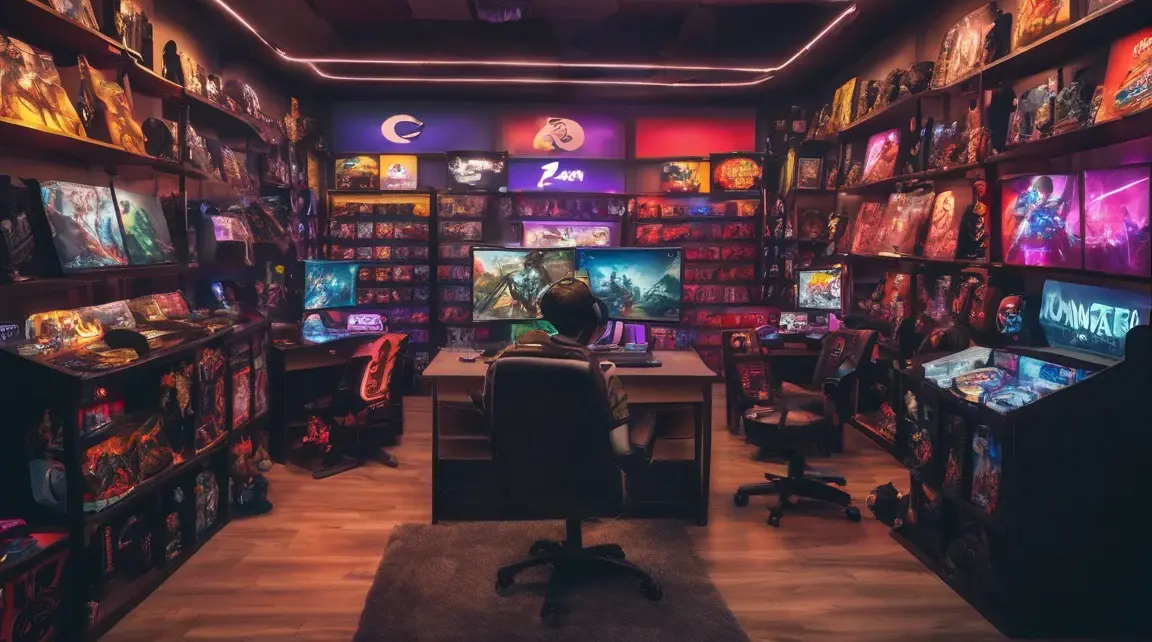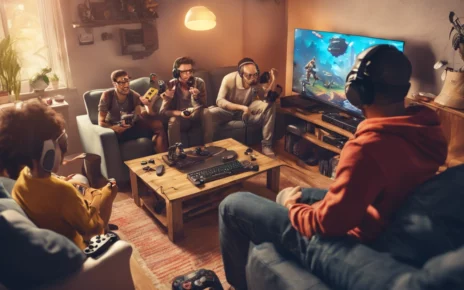Gaming isn’t just a hobby—it’s a lifestyle. And gamers love to show their passion through merchandise. Whether it’s a cozy hoodie with their favorite game logo or a collectible figurine of a beloved character, gaming merchandise is in high demand. If you’ve ever thought about turning your love for gaming into a profitable business, launching an online gaming merch store might be your next great move.
In this complete guide, we’ll walk you through every step of how to start a gaming merchandise business—from planning and product selection to marketing and scaling for long-term success.
Step 1: Research the Gaming Merchandise Market
Before launching any business, it’s important to understand the market you’re entering.
✅ Identify Popular Gaming Niches
- Focus on genres with loyal communities: battle royale games, RPGs, or eSports titles.
- Look at trending games: Use tools like Google Trends, Twitch, and Steam charts.
- Consider popular franchises like Minecraft, Zelda, Fortnite, Call of Duty, or Pokémon.
✅ Analyze the Competition
- Research existing gaming merch stores (both big brands and indie shops).
- Check what products they offer, price points, customer reviews, and shipping policies.
- Use platforms like Etsy, Redbubble, and Amazon for inspiration.
✅ Define Your Unique Selling Proposition (USP)
Ask yourself:
- What makes your store different?
- Will you offer exclusive, custom, or limited-edition designs?
- Are you targeting collectors, casual gamers, or esports fans?
Step 2: Define Your Target Audience
Understanding who you’re selling to is crucial for designing the right products and marketing effectively.
🎮 Segment Your Audience
- Casual Gamers: Interested in fun, wearable merch like t-shirts and mugs.
- Hardcore Fans: Likely to buy premium items such as replicas, figurines, and collectibles.
- Retro Gamers: Look for nostalgic items from older game franchises.
- Esports Enthusiasts: Might want team jerseys, gaming mousepads, or branded accessories.
🧠 Create Buyer Personas
Build fictional profiles of your ideal customers:
- Age, gender, interests
- Gaming platform preference (PC, console, mobile)
- Buying motivations (style, status, passion, fandom)
Step 3: Choose the Right Products to Sell
Now that you know your audience and niche, it’s time to decide what merchandise you’ll offer.
🛒 Best-Selling Gaming Merchandise Ideas:
- T-shirts and hoodies with custom or official game graphics
- Posters and wall art
- Keychains, pins, and enamel badges
- Action figures and collectibles
- Plushies and toys
- Phone cases and gaming accessories
- Mousepads, gaming mats, and desk décor
- Cosplay items or themed apparel
🎨 Tip: Start Small and Scale Up
You don’t need 100 products on day one. Start with 5–10 strong, well-designed items. Track what sells, then expand.
Step 4: Design Your Unique Product Line
Creating a memorable product line is key to building a loyal customer base.
🧑🎨 Collaborate with Designers
- Work with freelance artists or graphic designers on platforms like Fiverr, Upwork, or Behance.
- Communicate your ideas clearly—game inspiration, color themes, vibe, etc.
📦 Choose the Right Materials
- Prioritize comfort, durability, and detail.
- Partner with trusted suppliers or print-on-demand services that allow quality control.
- Check samples before listing products.
💡 Stand Out with Limited-Edition & Niche Items
- Offer exclusive drops based on trending topics.
- Use “scarcity marketing” to encourage quick purchases.
- Cater to micro-niches, like fans of lesser-known cult classics or indie games.
Step 5: Set Up Your Business Plan
A business without a plan is like a game without a strategy.
📊 Create a Simple Business Plan That Covers:
- Mission statement – Why you’re starting the store.
- Business goals – Short- and long-term (e.g., reach $5,000 in monthly sales within six months).
- Target audience – Who you’re selling to.
- Revenue model – Will you use print-on-demand, wholesale, or manufacture products yourself?
- Pricing strategy – Research competitors and factor in costs, margins, and buyer expectations.
- Marketing channels – Social media, SEO, influencer partnerships, etc.
⚔️ Run a SWOT Analysis
Identify:
- Strengths: Unique designs, community engagement
- Weaknesses: Small budget, limited stock
- Opportunities: Trending games, new platforms
- Threats: Competition, product delays
Step 6: Build Your Online Gaming Store
Now let’s bring your store to life online!
💻 Choose an eCommerce Platform
Popular platforms include:
- Shopify – Great for beginners with built-in features.
- WooCommerce (WordPress) – Flexible and ideal if you already have a blog.
- BigCommerce – Scalable for large product catalogs.
- Etsy – Good for custom or handmade gaming merchandise.
🧭 Make It User-Friendly
- Use intuitive navigation, categories, and filters.
- Optimize for mobile devices (most gamers shop on phones).
- Ensure fast load times.
🛒 Optimize the Checkout Process
- Accept multiple payment methods (PayPal, credit cards, Apple Pay).
- Offer guest checkout options.
- Keep shipping info and return policies transparent.
Step 7: Optimize for SEO from the Start
Search Engine Optimization (SEO) helps gamers find your merch when they’re searching online.
🔍 SEO Best Practices for Gaming Stores
- Use keywords like “best gaming merchandise,” “custom gamer t-shirts,” “video game collectibles” in product titles and descriptions.
- Add image alt-texts and optimized filenames.
- Include an FAQ page and blog with game-related content.
- Use clean URLs (e.g., yourstore.com/zelda-hoodie).
🧱 Build Backlinks
- Collaborate with bloggers, YouTubers, or podcasters to feature your store.
- Submit your site to directories and gaming communities.
Step 8: Launch Your Gaming Merch Store
The launch can make or break your first impression.
🎉 Pre-Launch Checklist
- Have 5–10 core products ready.
- Test website functionality on mobile and desktop.
- Prepare launch graphics and posts for social media.
🚀 Launch Tactics
- Offer early-bird discounts or bundle deals.
- Host a live stream on Twitch or YouTube.
- Run a giveaway contest for free merch to build email subscribers and followers.
Step 9: Promote Your Store & Build Your Brand
Marketing is how you attract traffic and convert visitors into buyers.
📱 Leverage Social Media
- Post regularly on Instagram, TikTok, and Twitter/X with game-inspired content.
- Use gaming hashtags like #gamermerch #videogamestore #gaminggear.
- Share behind-the-scenes content, product spotlights, and fan shoutouts.
🤝 Work with Influencers
- Find gaming streamers or YouTubers who align with your brand.
- Send free samples for unboxing videos or reviews.
📧 Use Email Marketing
- Collect emails through your site and social media.
- Send newsletters about new arrivals, exclusive sales, or game updates.
Step 10: Run and Scale Your Store
Once launched, focus on operations and long-term growth.
⭐ Prioritize Customer Service
- Respond to queries quickly and politely.
- Offer easy returns and clear shipping updates.
📦 Manage Inventory Efficiently
- Use inventory management tools to track stock levels and avoid over/understocking.
- Forecast demand during game launches or holidays.
📈 Measure Performance
- Track website traffic, sales conversions, and best-selling items.
- Use analytics to refine product offerings and marketing strategies.
🔄 Stay Flexible and Adapt
- Keep up with gaming trends, tech tools, and evolving customer behavior.
- Always look for ways to improve—new product lines, packaging upgrades, or platform expansion.
Final Thoughts: Level Up Your Gaming Merchandise Business
Launching a gaming merchandise store is an exciting way to combine passion with profit. With a smart strategy, targeted products, and consistent branding, your store can stand out in a thriving industry. Follow this step-by-step guide, and you’ll be well on your way to building a successful online business that gamers love.




